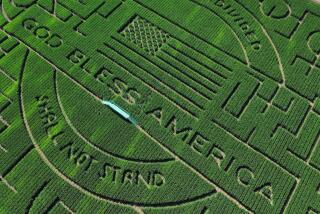It’s A-Mazing What Struggling Farmers Do to Get By
- Share via
SUSSEX, N.J. — Jonathan Clarke reached up to grab his mother’s hand as they prepared to plunge into the path through the 7-foot-high stalks of sorghum.
“We’re going in the jungle!” the 3-year-old told his mother, Lisa. “We’re going in the scary jungle!”
Using intuition, memory and a little bit of luck, Jonathan and his mother, like thousands of people before them, wound their way through the grasslike plant at Kuperus’ Farmside Gardens.
The giant maze is just one of many unconventional business ventures some struggling farmers use to get by.
“We need to seek these new activities in order to make a living,” Charlie Kuperus said.
Rising costs and stagnant commodity prices have hit farmers hard, forcing them to come up with ideas like the maze, said Zane Helsel, director of the Rutgers Cooperative Extension.
“You get a couple thousand kids out there . . . you’re going to make a lot more money than you would make for corn, which you are going to have to truck to market for cattle feed,” he said.
The other activities Helsel describes as “agri-tourism” include hayrides, haunted houses, egg hunts and bed and breakfasts.
The Kuperus farm, which includes a nursery and dairy farm, has been running a fall tour for children’s groups for 16 years. The new maze, opened in September, has become part of a $5 tour that includes a hayride, a tour of the dairy barn and a pumpkin for each child.
A much larger maze in Shippensburg, Pa., attracted 23,000 people over three weekends this summer, said Miriam Witter, whose husband, Jim, owns the farm.
That maze, made of corn on 30 acres of land, had about two miles of pathways. It was equipped with a sound system, treasure chests that contained partial maps of the puzzle and speaking tubes through which lost maze walkers could communicate with an elevated maze-master.
A professional maze designer made it look like Sir Francis Drake’s clipper, the Golden Hind.
Kuperus’ maze is not as extravagant. There are actually two: a half-acre maze for small children and a 1 1/2-acre maze for adults.
There are no clues: People who get lost rely on a low-tech method to find their bearings.
“If you get lost, yell, ‘Help,’ ” Kuperus said. “We will come to get you.”
Kuperus’ maze was designed in three hours by a landscape architecture student who worked at the farm over the summer. He attacked the sorghum with a weed whacker for three days and eventually cut a design that spells out “Kuperus.”
“This is the homemade maze,” Kuperus said. “We didn’t design it to be overwhelming.”
But a reporter and a photographer stumbled through the sorghum, hopelessly lost for 18 minutes before they found the exit.
The maze will remain until the sorghum, used for cow feed or fertilizer, is harvested in mid-November. Kuperus said he expects about 4,000 people to visit.
More to Read
Sign up for The Wild
We’ll help you find the best places to hike, bike and run, as well as the perfect silent spots for meditation and yoga.
You may occasionally receive promotional content from the Los Angeles Times.






